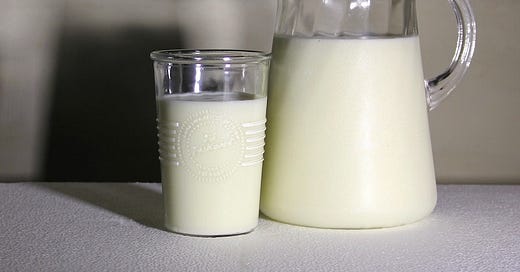Do You *Know* Where Your Raw Milk is Coming From?
Asking a few good questions is the difference between local clean milk and sketchy sourcing
Welcome to Raw Milk Mama, a newsletter about food freedom, our food systems, and how to create local food security in our communities. Sign up here for weekly posts, or keep reading…
If you value this content, please consider a paid subscription.
Raw milk is really hard to find at times.
Especially clean, safe milk from a producer you can trust.
It can be difficult to know where to look or what sources to trust even if you happen to find a place that provides it.
There are many questions to consider including how the milk is produced, what safety measures the farm follows, and the type of cows they are milking (this is usually for personal preference and not a safety issue.)
A recent experience highlighted this.
I was helping a friend of mine in Florida find a source for clean, safe raw milk near her.
She showed me a website where she’d gotten raw milk before. There was an extensive list of products available.
“Wow” I thought. “There’s so much they are providing.”
I was surprised to see the full extent of what this “farm” was offering, under their branding, considering that Florida only has raw pet milk available.
(Yes, it also really helps to know the laws and regulations for the state where you’re looking.)
I called the farm to ask some of the questions I always ask to verify a new source.
Starting with….
“Where is your milk coming from?”
This is a vitally important question to ask for multiple reasons.
You want to see if the milk is actually coming from the “farm” or brand marketing it. The answer to this question will inevitably lead to other questions. They might be outsourcing, in which case, you’ll want to know that right up front. This question also helps you see and understand the relationship between the farm and whoever else might be involved in processing or delivering it. Ultimately, you need to understand the standards for how the milk is produced and how it gets to you.
It’s currently illegal to transport raw milk for human consumption across state lines so you always want to be aware if/when that is happening so you can better understand the processes and/or values and integrity of those providing the milk. This is a starting point to understand the milk, not an ending point.
It’s important to understand HOW they answer this question. Do they answer it with information and straightforward answers? Or do they dodge questions and get defensive?
So back to the call.
Remember, this is a Florida “farm.”
The employee on the other end of the line told me that all the milk and dairy products come from “The Amish Community in Pennsylvania.”
Oh boy!
All my alarm bells started clanging loudly!
I asked what farm and he couldn’t tell me. He kept repeating “The Amish Community in Pennsylvania.”
We’re not talking about a neighboring state here. It’s not Ohio or Maryland or even New York. Florida is 5-6 states and 1000+ miles away! (This was a “farm” in Southern Florida.)
This means something to me as it should mean something to anyone hearing this:
The milk is being commingled from multiple sources without regard to safety standards.
You have NO IDEA how it’s been handled. Such as, when it was milked, how it was transported from farm to farm, how it was cooled, how it’s bottled, and much more.
It’s almost assuredly coming from unpermitted, uninspected farms who flaunt safety standards and actually mock people who care about clean, safe raw milk. (That’s the prevailing mindset of the “community in PA” that readily sources raw milk and raw milk products across state lines with no safety or cleanliness standards in place.)
The “farms” participating are taking enormous regulatory and legal risk in transporting raw milk 100s-1000s of miles away with no guiding principles for consumer safety in mind.
The milk will likely not last more than a few days before souring.
The maps and resources available on the internet that show where you can find raw milk are, ostensibly, so that you can find local *sources* of raw milk near you.
These maps and sources do not do any vetting or provide any additional verification of standards or transparency in their listed sources. That is entirely your responsibility.
And it’s no longer acceptable to assume that raw milk available “locally” (wherever you are) is actually produced locally – even if it’s branded with a local farm name or brand.
Do not assume.
This is why asking basic questions is important.
Milk from that far away likely also means that by the time that milk gets to you it’s at least several days old. This means, at best, you’re getting milk that will likely sour exponentially quicker than bonafide local milk.
If you are paying $14+ per gallon for milk (as this “farm” was charging), one should expect to get a high quality product.
It’s not high quality if it is blindly commingled, sours in a few days or is produced and shipped via subpar standards..
You don’t need to accept that.
This also means it is vitally important to work hard to make changes in each state so we can all have access to clean, safe raw milk.
I am grateful for all the recent influx of new subscribers. Thank you to all who have upgraded to paid subscriptions recently. Your messages and notes are encouraging and uplifting. You are the reason this work can continue.
Some have asked about making a one-time gift. Yes, you can contribute here. My family thanks you for investing in my writing.
For more content, sign up for daily emails about our food systems or listen to the Nourishing Liberty Podcast.





